Geese often take a backseat to their more popular feathered counterparts such as chickens and ducks. These majestic birds have a rich history intertwined with human civilization that spans centuries.
From providing feathers for quills in writing instruments to serving as loyal guardians on farms, geese have played diverse roles in various cultures around the globe.
We will study the fascinating world of Domestic Geese Breeds, each with its unique characteristics and quirks that make them a valuable addition to any homestead or farmyard.
Domestic Geese Breeds
1. Emben Goose
Emben geese, also known as Embden geese, are a popular domestic breed known for their striking all-white appearance with orange bills and legs. Originating from Emden in Germany, this breed has a long history dating back to the thirteenth century.
They are larger and heavier than many other goose varieties, making them well-suited for commercial meat production.
With their distinctive white plumage and orange bill, They are characterized by their oval-shaped heads, blue eyes, and stocky build. Their size and weight make them a preferred choice for farmers looking to raise geese for meat production.
Despite the prevalence of white-colored feathers in some commercially raised geese, true Emben geese can be identified by their specific physical features that set them apart from other breeds.
2. Toulouse Goose
They are named after their origin in Toulouse, France, and are a popular breed among poultry keepers for various reasons. Known for their relaxed and slow-paced nature, these geese are becoming increasingly popular in Europe as pets or for business purposes.
Their bulky body shape and white plumage make them distinctive, and their heavy bodies make them a delicious table bird, often used in the French delicacy Pt de foie gras due to their oversized liver.
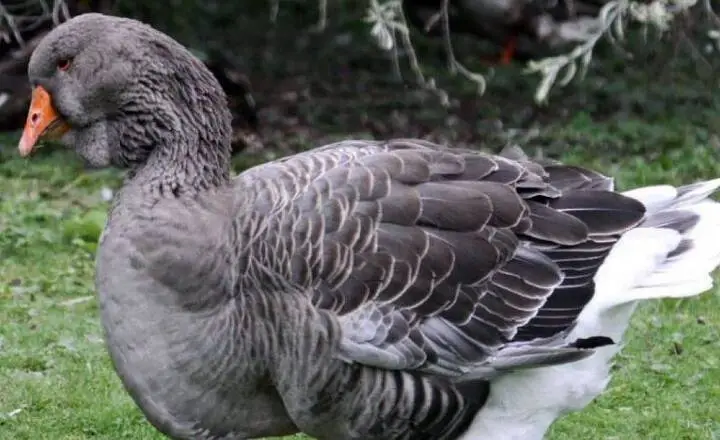
These barnyard cuties are prized for their calm demeanor and ease of care, making them an attractive option for both novice and experienced bird owners.
Whether kept for companionship or culinary purposes, Toulouse Geese are versatile creatures that bring joy to those who choose to raise them. Their popularity continues to grow as more people discover the unique charm and benefits of having these geese on their farms or homesteads.
3. Chinese Goose
The Chinese Goose is a striking and elegant domesticated breed originating from China, known for its distinctive knob on the beak. These geese are not only beautiful but also friendly and sociable, making them great companions for humans and other poultry.
Their curvaceous appearance may be deceiving as they are heavier than they appear due to their closely fitted feathers. With popular color variations in brown and white geese are aesthetically pleasing and practical for weeding tasks, as they have a voracious appetite for all kinds of weeds.
Aside from their beauty and social nature, Chinese Geese are valued for their egg production capabilities. They are prolific layers, producing around 60-80 eggs per year, making them a valuable asset for those looking to harvest fresh eggs regularly.
Their knack for weed control adds another layer of usefulness to these geese, making them a versatile and practical choice for farmers and hobbyists alike.
4. African Goose
It is a unique breed that despite its name, does not actually originate from Africa. Its origins are traced back to various countries in Europe and North America, with theories suggesting it was developed through the crossing of wild swan geese and Chinese geese.
This breed is known for its massive size, heavy body, thick neck, stout bill, and jaunty posture. Despite laying fewer eggs compared to other domestic breeds, African Geese are popular for their meat production capabilities and their ability to thrive in various climates with minimal care.
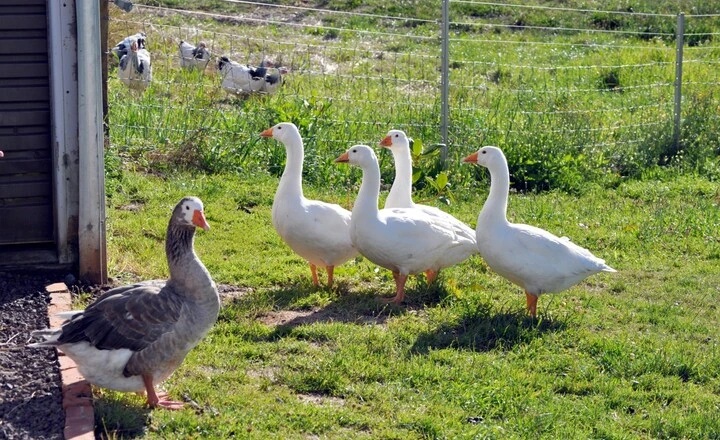
Due to its hardy nature and low maintenance requirements, the African Goose is a favored choice for those looking to raise geese for meat production.
While its name may be misleading in terms of origin, the characteristics and adaptability of this breed make it a valuable addition to any farm or homestead.
With proper care and attention, African Geese can provide a sustainable source of meat while requiring minimal resources in return.
5. Pilgrim Goose
Despite its name suggesting a historical connection to the Pilgrims, is actually a relatively new breed with origins in the United Kingdom. Known for their unique ability to be distinguished by gender at any age, Pilgrim geese have silver-yellow males and olive-gray females.
Their calm and personable nature, along with their moderate size and plump bodies, make them a popular choice for home flocks.
The population of this breed has declined significantly, leading to its classification as critical by the American Livestock Breeds Conservancy.
Being favored for their sweet temperament and docile disposition, They are also raised commercially for meat due to their relatively quick growth rate.
Despite not having a long history like some other domestic goose breeds, the Pilgrim Goose has quickly gained popularity among farmers and homesteaders alike for their unique characteristics and versatility.
6. Pomeranian Goose
They are also known as the R gener goose, a historic breed of domestic goose originating from Germany. Developed by farmers in Pomerania as far back as 1550, this breed is known for its utilitarian purposes and unique physical characteristics.
As the oldest domestic goose breed in Germany, the Pomeranian Goose has declined in popularity in recent years. It comes in various color variations and is recognized for its stout necks, protruding breasts, and rounded bodies.
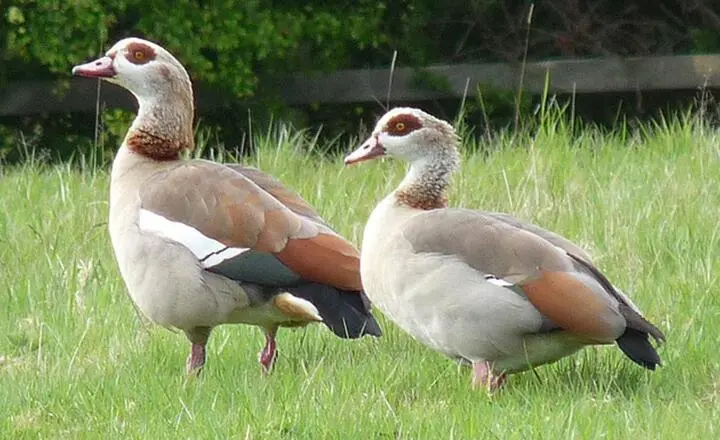
These geese are valued for their ornamental appeal due to their distinctive looks and patterns and their meat production and egg-laying capabilities.
With an average yield of 70 eggs per year and a significant amount of breast meat, they are utilized in various delicacies specific to the Pomeranian region.
While some individuals may exhibit aggressive behavior towards humans, these social and chatty birds are known to be quite noisy and welcoming towards visitors. They remain an exciting breed with both practical and aesthetic qualities.
7. American Buff Goose
The American Buff Goose is a charming domestic breed native to the United States, known for its apricot-fawn feathers and bright white underside.
Developed from the wild Greylag goose, this medium-sized breed has become a popular choice for large and small-scale farming operations.
With their orange bills, brown eyes, and pale pink legs, these geese are aesthetically pleasing and have a calm and docile temperament that makes them well-suited for home flocks.
The key advantage of raising American Buff Geese is their dual-purpose nature – they can be utilized for both egg production and meat consumption.
Their sweet temperament and excellent parenting skills make them ideal for farmers looking for a versatile and reliable breed.
8. Steinbacher Goose
They are also known as the Steinbacher Kampfgänse, a unique domestic goose breed originating from Germany. Developed in Thuringia in the early 20th century, this breed is believed to be a cross between Chinese and local German geese.
Although it originated as a fighting breed, the Steinbacher Goose is known for its calm disposition toward humans and flock members.
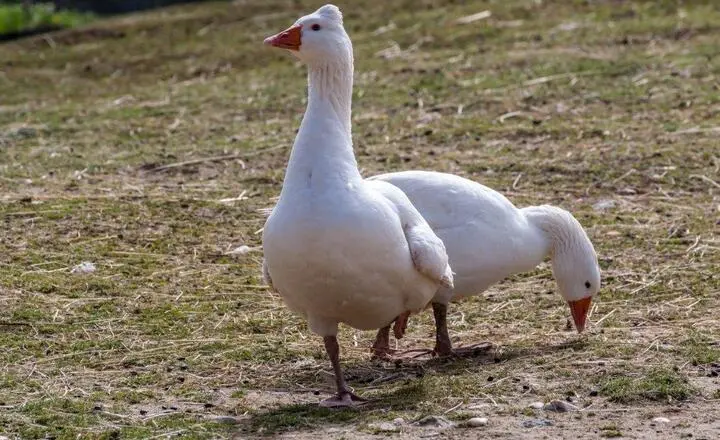
With its striking grey, blue, buff, and cream colorings and distinctive orange bill with a black bean at the end resembling black lipstick, these birds are often used for shows and exhibitions.
While the Steinbacher Goose may not be reliable for egg production due to their reluctance to sit on eggs, they are valued for their meat production capabilities.
They lay around 10 to 20 eggs annually and form strong bonds within their flock. This breed’s proud posture and unique physical attributes make them popular for exhibition purposes, showcasing their beauty and distinct characteristics to enthusiasts worldwide.
9. Scania Goose
It is a breed indigenous to the Scania region of Sweden. Developed in the late nineteenth century from German waterfowl brought to Sweden in the 1700s, these geese are believed to be a cross between Pomeranians and local geese populations.
They are the largest and heaviest domestic goose breed, sharing similarities with Pomeranian geese. Despite their variable temperaments – usually calm but potentially aggressive during breeding season – they are hardy enough to withstand outdoor conditions in Southern Sweden year-round.
With white plumage and distinctive brown-grey markings on their head, neck, back, thighs, and rump feathers, mature male Scania Geese can weigh between 7 and 11 kgs.
Known for their good behavior and attentive parenting skills, they are well-suited for meat production, egg laying, and ornamental purposes worldwide.
Their unique characteristics make them a valuable addition to farms and homesteads seeking versatile poultry breeds.
10. Shetland Goose
Originating from Scotland’s Shetland Islands they are often mistaken for the Pilgrim Goose. This breed has evolved to thrive in rough terrains and is known for its robust health with fewer issues compared to other varieties.
Slightly smaller than common white farmyard geese, they are easily distinguishable by gender. The Shetland Goose is characterized by its quiet, curious, calm, and friendly nature, making it an ideal choice for backyard flocks.
These geese form monogamous pairs for life and protect their partners, ensuring no other flock member encroaches on their bond.
With distinct physical features such as white plumage and blue eyes in males and a half-white, half-gray saddleback pattern in females, the Shetland Goose is a visually striking breed.
Raised primarily for meat production and graze pastures to control grass parasites, these geese offer practical benefits and companionship within a flock setting.
Their unique characteristics and adaptability to various environments make them a valuable addition to any poultry operation or hobbyist’s backyard flock.
11. Sebastopol Goose
The Sebastopol goose is a unique and beautiful domestic breed that originated in Sebastopol. Known for their long, slender necks and distinctive curly feathers, these geese are popular for their ornamental qualities and practical uses.
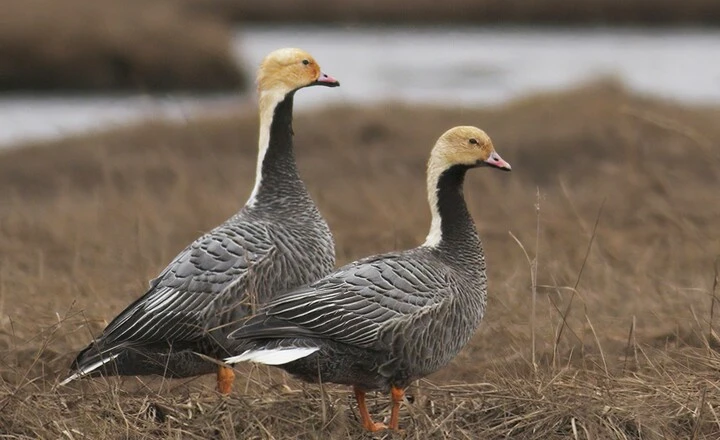
Their webbed feet make them excellent foragers, and they are known to be good-natured and relatively slow-moving birds.
The key benefit of raising Sebastopol geese is their versatility they are great sitters and moderate layers, suitable for both egg production and meat consumption.
Through selective breeding and crosses, different color variants, such as all-gray, buff, and saddleback, have been developed to cater to various preferences. They are a valuable addition to any poultry flock, offering aesthetic appeal and practical benefits.
Conclusion
These Domestic Geese Breeds comes with its own unique characteristics and traits. From the iconic Toulouse to the charming Sebastopol, these birds offer both practical benefits and aesthetic appeal to those who choose to keep them.
By understanding the differences between breeds, potential owners can make informed decisions on which type of geese best suits their needs and preferences.
Whether for ornamental purposes or as reliable farmyard companions, domestic geese breeds provide a delightful addition to any home or homestead.
FAQs
Can pet geese fly away?
Pet geese can fly away if they are not properly cared for or contained. Geese are strong fliers and can cover long distances when they take flight.
What are geese afraid of?
Geese are generally afraid of loud noises, sudden movements, and anything they perceive as threatening. They are susceptible to predators such as dogs, foxes, and humans.
What smell do geese hate?
Geese have a strong aversion to certain scents, with one of the most common being the smell of citronella.
